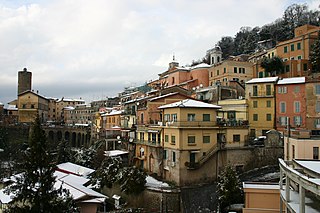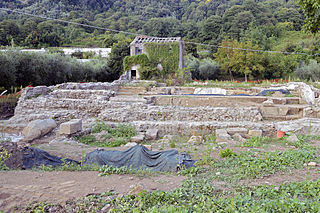
Pisa is a city and comune in Tuscany, central Italy, straddling the Arno just before it empties into the Ligurian Sea. It is the capital city of the Province of Pisa. Although Pisa is known worldwide for its leaning tower, the city contains more than twenty other historic churches, several medieval palaces, and bridges across the Arno. Much of the city's architecture was financed from its history as one of the Italian maritime republics.

The Vatican Museums are the public museums of the Vatican City. They display works from the immense collection amassed by the Catholic Church and the papacy throughout the centuries, including several of the most well-known Roman sculptures and most important masterpieces of Renaissance art in the world. The museums contain roughly 70,000 works, of which 20,000 are on display, and currently employ 640 people who work in 40 different administrative, scholarly, and restoration departments.

Vaglio Basilicata is a town and comune in the province of Potenza, in the Southern Italian region of Basilicata. It is bounded by the comuni of Albano di Lucania, Brindisi Montagna, Cancellara, Pietragalla, Potenza, Tolve and Tricarico.

Nemi is a town and comune in the Metropolitan City of Rome, in the Alban Hills overlooking Lake Nemi, a volcanic crater lake. It is 6 kilometres (4 mi) northwest of Velletri and about 30 kilometres (19 mi) southeast of Rome.

Sinopia is a dark reddish-brown natural earth pigment, whose reddish colour comes from hematite, a dehydrated form of iron oxide. It was widely used in Classical Antiquity and the Middle Ages for painting, and during the Renaissance it was often used on the rough initial layer of plaster for the underdrawing for a fresco. The word came to be used both for the pigment and for the preparatory drawing itself, which may be revealed when a fresco is stripped from its wall for transfer.

The National Railway Museum of Pietrarsa lies beside the Naples–Portici railway, between the city of Naples and the towns of Portici and San Giorgio a Cremano. Pietrarsa is an area among these villages in the past known as “Pietra Bianca” but it was renamed Pietrarsa after the eruption of the Vesuvius in 1631.

The Natural History Museum of the University of Pisa is a natural history museum in the city of Pisa in Tuscany, Italy.

Sammarinese Museum of Ancient Arms is located in the Cesta, the second tower of San Marino. The museum opened in 1956 due to agreement with Sammarinese collector Giovanni Carlo Giorgetti. Exhibition, divided to four rooms, contains about 2000 ancient arms and armours. It is part of the Musei di Stato.

The Lucan portrait of Leonardo da Vinci is a late 15th- or early 16th-century portrait of a man that was discovered in 2008 in a cupboard of a private house in Italy. It strongly resembles a portrait of Leonardo da Vinci by Cristofano dell'Altissimo held by the Uffizi Gallery. The painting was previously thought by its owners to represent Galileo but on its discovery a claim was made that it is a self-portrait by Leonardo da Vinci. Alessandro Vezzosi, director of the Museo Ideale Leonardo da Vinci at Vinci said in 2011 that he had excluded the possibility that it was a self-portrait, but that the painting "remains intriguing because it adds a new element to the Leonardo puzzle".

Galileo Chini was an Italian decorator, designer, painter, and potter.

Igino Benvenuto Supino was an Italian painter, art critic, and historian.

Pliophoca is an extinct genus of seal in the family Phocidae.

Ebe is a former training ship of the Italian Navy. Initially a merchant vessel named San Giorgio, she was acquired by the Navy and used to train non-commissioned officers between 1952 and 1958. Since 1963 she has been preserved and exhibited at the Museo Nazionale Scienza e Tecnologia Leonardo da Vinci in Milan.
Christian Greco is an Italian Egyptologist. Since 2014 he is the Director of Museo Egizio, Torino.

The Temple of Diana Nemorensis was an ancient Roman sanctuary erected around 300 BC and dedicated to the goddess Diana. The temple was situated on the northern shore of Lake Nemi, beneath the cliffs of the modern city of Nemi. It was a pilgrimage site on the Italian peninsula. The temple complex covered an area of 45,000 square meters.
Carlo De Simone is an Italian linguist, specializing in Ancient Greek and Latin texts and Etruscan epigraphs. He is best known for his research into Etruscan, Lemnian and Rhaetian languages.

Alkedo is a preserved Roman shipwreck that sank in the 1st century AD, and was discovered during a construction project in Pisa, Italy.

The Arianese dialect, typical of the territorial area of Ariano Irpino, is a vernacular variety of the Irpinian dialect, belonging in turn to the Neapolitan group of southern Italian dialects. Like all Romance languages, it descends directly from Vulgar Latin, a language of Indo-European stock that has been widespread in the area since Roman times.





















